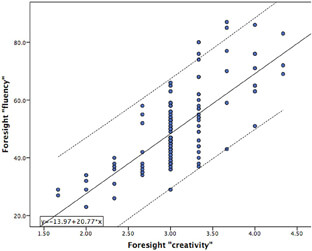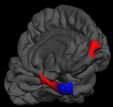Rex E. Jung, Ph.D.

Are you more likely to come up with a creative idea if you produce many ideas? This question is at the core of the “equal-odds” rule, formulated by Dean Keith Simonton, who has observed that highly creative individuals tend to put out a lot of ideas. Pablo Picasso is, perhaps, best known for his masterpiece Guernica, which attempts to translate the horrors of war. However, over the course of his career, he produced over 25,000 individual pieces of art. Beethoven, Curie, Hemingway—all have their best known work (e.g., 9th Symphony, discovery of Radium, Old Man and the Sea), but few know the dozens, or even hundreds of works that lie beneath such masterpieces of creative accomplishment. But these famous examples are far removed from the rest of us, who strive to be creative in our daily lives. So, we attempted to determine if the quantity of ideas led to higher quality of ideas, by using the Foresight test from the Johnson O’Connor battery.
The Foresight test is particularly well suited to such a study, as it asks subjects to look at a design (say a zig-zag) and “write down as many things as you can that the drawing makes you think of, looks like, reminds you of, or suggests to you.” We had some 246 participants undertake this activity over six such designs in our research project, which also included measures of intelligence, personality, creative achievement, and brain structure and function (using magnetic resonance imaging—MRI). The Foresight measure has long been considered by Johnson O’Connor to be a measure of the ability to “see possibilities” which is “focused best through a long-term goal.” We measured two aspects of performance on the Foresight test—the number of items produced by each participant (i.e., the quantity), and the creativity of the overall production of each participant (on a simple scale, with 1 being least creative and 5 being most) as assessed by a panel of three judges matched to participant age and gender.

What we found was fascinating. First, we observed that the number of Foresight items generated was correlated with other measures of creativity, including Openness to Experience (a personality scale that is part of the Big 5 personality test), and the Creative Achievement Questionnaire (things participants had actually achieved in the world across artistic and scientific domains). These correlations were fairly low (.15 – .17) but encouraging given that other tests of creativity, focused on divergent thinking (the production of many examples of uses for a common target item such as a brick) are related to such measures. So, Foresight was functioning like a measure of divergent thinking in terms of fluency or quantity of ideas generated. What was most interesting, however, was that the quantity of ideas was related to the judged quality or creativity of ideas to a very high degree—the correlation between quantity and quality was .73. The number of ideas did lead to greater likelihood of producing higher quality of ideas, just as the equal-odds theory predicted! This is the first time that this relationship has been demonstrated in a cohort of “low creative” subjects as opposed to the likes of Picasso, Beethoven, or Curie.

Finally, we were interested in whether cortical thickness (this is the 2-4 millimeters of gray matter at the surface of the brain made of neuron cell bodies—the central processors of the neuron) was associated with either fluency or creativity measures of the Foresight task. Most interestingly, we found that thickness of the left frontal pole was associated with both higher fluency and higher creativity across subjects. This brain region is particularly interesting in that it has been associated with “thinking about one’s own future” and “extracting future prospects” (Okuda et al., 2003). In a large study focused on a concept known as episodic future thinking, researchers noted that a network of brain regions which overlapped those in our study (left frontal pole—parahippocampal gyrus) was associated with: 1) adaptive decision making, 2) creation of abstract knowledge or schemas, and 3) integration of novel experiences into pre-existing knowledge networks (Stawarczyk & D’Argembeau, 2015). Our study showed that subjects with thickening of the frontal pole and parahippocampal gyrus produced more and better ideas; the implication from other studies would be that they are also better at future thinking, just as the Foresight test has been thought to measure.
Jung RE, Wertz CJ, Meadows CA, Ryman SG, Vakhtin AA and Flores RA (2015) Quantity yields quality when it comes to creativity: a brain and behavioral test of the equal-odds rule. Front. Psychol. 6:864. doi: 10.3389/fpsyg.2015.00864
Okuda, J., Fujii, T., Ohtake, H., Tsukiura, T., Tanji, K., Suzuki, K., et al. (2003). Thinking of the future and past: The roles of the frontal pole and the medial temporal lobes. Neuroimage 19, 1369-1380. doi: 10.1016/S1053-8119(03)00179-4
Stawarczyk, D., and D’Argembeau, A. (2015). Neural correlates of personal goal processing during episodic future thinking and mind-wandering: an ALE meta-analysis. Hum. Brain Mapp. doi: 10.1002/hbm.22818
















